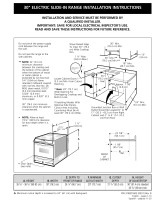
Notas importantes para el instalador
1. Leatodas las instrucciones contenidas en este manual
antes de instalar la estufa.
2. Saque todo el material usado en el embalaje del
compartimiento del horno antes de conectar el
suministro el_ctrico a la estufa.
3. Observe todos losc6digos y reglamentos pertinentes.
4. Deje estas instrucciones con el comprador.
5. Parafacilitar la instalaci6n puede quitarse la puerta
del horno.
6. No levante la estufa por la manija de la puerta.
Nota importante para el consumidor
Conserve estas instrucciones y el Manual del Usuario para
referencia futura.
IMPORTANTES
INSTRUCCIONES DE
SEGURIDAD
• Aseg_rese que su cocina est_ instalada y
conectada adecuadamente a tierra por un
instalador calificado o un tdcnico de servicio.
• Esta cocina debe ser conectada a tierra
eldctricamente de acuerdo con los codigos
locales, o de no existir, con la National Electrical
Code ANSI/NFPA No.70- _ltima edici6n.
• La instalaci6n de el_ctrodom_sticos destinados para
casas (movibles) deben conformarse con la
Manufactured Home Construction and Safety
Standard, t[tulo 24CFR, parte 3280 [antiguamente la
Federal Standard for Mobile Home Construction and
Safety, t[tulo 24, HUD (parte 280)] o cuando este
c6digo no se aplica, la Standard for
• Todas las cocinas pueden inclinarse.
• Esto puede provocar lesiones personales.
• Instale el dispositivo anti-inclinaci6n que
viene con la cocina.
Para reducir el riesgo de
que sevuelque la estufa, hay que asegurarla
adecuadamente coloc_ndole los soportes
antivuelco que se proporcionan, para
modelos con elementos de bobina. Las
piezas seencuentran en un saco de plastico en el horno. Para
modelos de tapa lisa, el soporte antivuelco que se encuentra
al fondo de la estufa cabe debajo del tablero y evita que la
estufa se vuelque. Si no se instalan los tornillos antivuelco, la
estufa podr_ volcarse si se le pone peso excesivo en la puerta
abierta o si un ni_o se sube a 611a.Esto puede resultar en
da_o serio si liquidos calientes se derramaran o si la estufa se
cayera.
Manufactured Home Installation 1982 (Manufactured
Home sites, communities and setups) ; ANSIZ225.1/
NFPA 501A- 01tima edici6n o con c6digos locales.
• Aseg_rese que el empapelado de pared alrededor
de la cocina pueda resistir el calor generado por
la cocina.
Antes de instalar la cocina en una &rea cubierta
de linoleo o cualquier otro revestidor de piso
sint_tico, aseg_rese que _ste pueda resistir al
menos 90°F sobre la temperatura de la pieza sin
encogerse, ladearse o descolorisarse. No instale la
cocina encima de una alfombra a menos que coloque
una placa de aislamineto o una plancha de 1/4" de
madera entre la cocina y el alfombrado.
Nunca deje a los nifios solos o sin
cuidado en el area donde el el_ctrodom_stico et& en
uso. A medida que los nihos crezcan, ens_heles el uso
adecuado de los el_ctrodom_sticos.Nunca deje la puerta
del horno abierta cuando la cocina est_ sin supervisi6n.
Pisar, apoyarse o sentarse en las
puertas o los cajones de la cocina pueden causar
graves herridas y tambi_n dafiar la cocina.
• No coloque cosas que atraigan a los ni_os sobre
los gabinetes encima de la cocina. Los ni_os
podrian sufrir quemaduras tratando de alcanzarlos.
• Para eliminar la necesidad de ir a buscar algo por
encima de los quemadores, no coloque gabinetes
por encima de _stos.
• No use el horno como espacio de
almacenamiento. Esto crea una situaci6n muy
peligrosa.
• Nunca use su cocina para calentar la pieza. El uso
prolongado de la cocina sin ventilaci6n adecuada
puede ser peligroso.
• No guarde o use gasolina u otros vapores
inflamables y liquidos cerca de _ste o cualquier
otro el_ctrodom_stico. Esto podr[a causar una
explosi6n o un incendio.
• Vuelva a programar todos los controles a la
posicibn "off" (apagado) despu_s de haber
utilizado el conteo contador autom&tico.
PARALOSMODELOS CON AUTO-LIMPIEZA:
• Retire el rostisador, la comida y otros utensilios
antes de auto-limpiar el horno. Limpie todo exceso
de derrames. Siga las instrucciones para la pre-
limpieza en el Manual del usuario.
8












